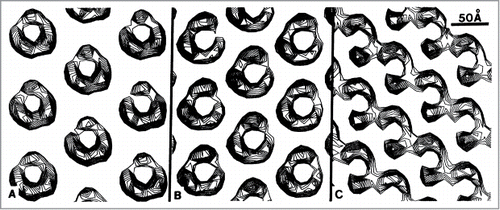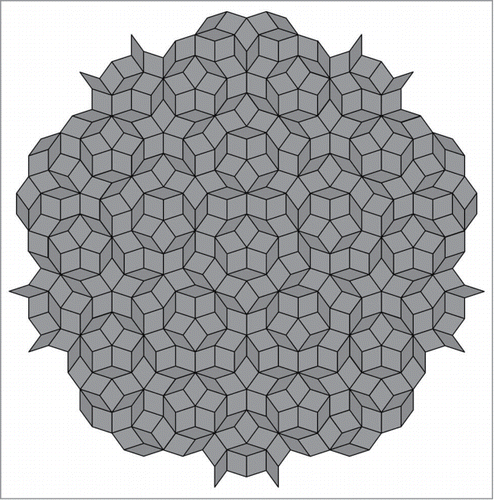Abstract
Neuron neurotransmitter receptors are in general pentameric. This enables them to form pentagonal components in biological quasicrystals (similar to mathematical aperiodic tilings). As quasicrystals have been proposed to require quantum effects to exist this might introduce such effects as a component of neurotransmission and thus consciousness. Microtubules may play a role in the clustering of the receptors into quasicrystals, thus modulating their function and may even form quasicrystals themselves. Other quaiscrystals in neurons are potentially formed by water, cholera toxin complexes, and the cytoskeletal components actin and ankyrin.
Quasicrystals and Consciousness
The pentagon is a form found commonly in nature, in everything from flowers to hurricanes. It (or rather the pentacle) is also the shape of the path described by Venus in the night sky which has led to its association with witchcraft and devilry. Aperiodic tilings in mathematics have been attracting interest as they reflect the structures found in various metallic alloys called quasicrystals. Yet another example of where mathematical concepts have expression in the physical world. These structures, like aperiodic tilings (), have local 5-fold symmetry but overall a crystal structure. Under the rules of traditional physics they should not exist. Crystalline forms are nature seeking the lowest energy configuration. Roger Penrose has proposed that, since coordination of subunits in quasicrystals requires a global solution, non-localized quantum effects are at play.Citation1
Unfortunately, much older ultrastructural research is somewhat overlooked today despite the amazing detail of subcellular structures it reveals. In a previous paper I suggested that the pentagonal arrays of ribosomes found in fertilized eggs from the fern Pteridium aquilinum form a biological quasicrystal.Citation2 As both consciousness and plant growth and development may be theoretically irreducible, quantum mechanics may be at the heart of both phenomena. Indeed the high fractal dimensionality of EEG data suggests that extra dimensions of quantum gravity may be involved in brain function.Citation3 There is currently considerable investment in attempts to create artificial quantum computers that utilize quantum bits (“qubits”), as they are seen as potentially vastly more powerful than “so-called” conventional computers.
Various theories of consciousness have tried to incorporate quantum mechanics but have proven to be inconclusive. One theory suggested that microtubules are key to consciousness, with tubulin subunits forming a “Bose-Einstein condensate” that enables quantum computing to take placeCitation4 but this is highly contentious and may just be wrong.Citation5 It would seem more likely that consciousness emerges from the underlying geometry of the nervous system. However, microtubules do appear likely to play a key role as anesthetics are known to disrupt microtubules and induce memory loss, although they also affect other cellular components including loss of membrane constituents.Citation6 Many other lines of evidence link microtubules to consciousness (and memory) and the actin cytoskeleton also appears to be important here.Citation2
So do quasicrystals play a role in animal consciousness? Some anesthetics target neurotransmitter receptors. Neurotransmitter receptors are often pentameric and indeed pentagonal in cross-section.Citation7,8 This means that they have the potential for participating as components of a pentagonal aperiodic tiling. There is evidence that this is exactly what occurs. Acetylcholine receptors form crystalline arrays in membranes of Torpedo californica, clearly an aperiodic tiling with local 5-fold symmetry Citation9 (). Indeed this study was later improved upon in some regards showing unequivocally that the 5 subunits of acetylcholine receptors form a pentagonal structureCitation10 although this second study didn't look at the supermolecular arrangement of receptors. One further study that did look at supermolecular arrangement concluded that receptors were randomly oriented in a lattice, again suggesting a quascrystalline array.Citation11 The results of this study also indicate that the neurotransmitter receptors may be able to shift from one quasicrystalline formation to another, depending on localized conditions. The Duckett study shows that this may be a common property of biological quasicrystalsCitation1 with presumably membrane lipids forming the other components of the aperiodic tilings.
Figure 2. Filtered projection views of membrane-bound AcChoR pentameric oligomers displayed as density contour maps. The maps clearly show an aperiodic crystalline configuration. (A) Reconstructed from the structurally better preserved A surface of the tube. The stain-filled groove faces to the left for 5 of 7 tubes. (B) Reconstructed from the A surface of the tube. The groove faces to the right for 2 of 7 tubes. (C) Reconstructed from the more distorted B surface of the tube. All images are oriented such that the tube axis is vertical. The a lattice direction is always parallel to the tube axis; the b lattice direction is 125 degrees clockwise from a in A and B and is 132 degrees counterclockwise from a in C. From ref.9 and used with permission.

So what role do microtubules play? It appears that microtubules contribute to the clustering of neurotransmitter receptors as when they are depolymerized with a drug, thus disrupting clustering of GABAA receptors, GABAergic currents in hippocampal neurons are affected.Citation12 This also demonstrates that the ordering of, and interaction between, neurotransmitter receptors in the plasma membrane is crucial to their function. This is possibly because it allows non-localized quantum-mechanical linkage between individual receptors, in fact linkage across the entire array of receptors. Quasicrystalline arrays of neurotransmitter receptors, apart from acetylcholine receptors, have yet to be shown definitively. This may be due the complexity of the aperiodic tilings present and/or local changes from one form of aperiodic tiling to another. Interestingly though, cholera toxin B-subunit (which increases neurotransmitter release from nerve terminalsCitation13 but also binds postsynaptically) forms locally pentagonal quasicrystals when bound to its membrane receptor in phospholipid bilayers.Citation14
Microtubules play other important roles in neurotransmission, including the propagation of electrical signals generated during the process.Citation15 There is even evidence from the housefly interfacetal hair mechanoreceptorCitation16 and in vitro studiesCitation17,18 that microtubules may form quasicrystals in tandem with associated proteins or ions, when conditions allow. These quasicrystals have a 13-fold local symmetry (due to the 13 protofilaments that make a microtubule) but overall 5-fold or 6-fold symmetry. The occurrence of pentagonal microtubule bundles suggests that these bundles may in turn be capable of forming a quasicrystal with local 5-fold symmetry; a sort of fractal quasicrystal.
Other quasicrystalline configurations may be involved. It has recently been shown that water can form quasicrystalsCitation19 and pentameric neurotransmitter receptors have been shown to contain a pentagonal arrangement of water molecules.Citation20 A number of other dodecahedral subcellular structures including clathrin coats and viruses, display pentagonal forms but, at least in the case of clathrin (which participates in postsynaptic endocytosis), these may not require complex topological rearrangements and thus quantum mechanical processes to form.Citation21 Interestingly axons have been shown to possess periodic 1D structures perpendicular to their axis containing actin and associated proteins, with the actin filaments sometimes taking a pentagonal form.Citation22 The scaffolding protein ankyrin, which regulates presynaptic microtubules and trans-synaptic cell adhesion at the neuromuscular junction, sometimes takes pentagonal form.Citation23 Are these cytoskeletal structures involved in consciousness or perhaps memory? There is much still to be revealed. For example, how might physically separated arrays of neurotransmitter receptors link to one another.
Interestingly, quasicrystals may be one way in which subcellular golden ratio-based structures can arise in biological systems since the packing density of pentilings (pentagonal tiling arrays, closely related to aperiodic quasicrystals) approaches τ/2 as pentile number, and similarity to an infinite aperiodic array, increases. The golden ratio may feature in the formation of consciousness as it is consistently seen as beautiful across various cultures.
As to the presence of similar states of consciousness in organisms apart from animals, this may only be possible if they possess pentameric receptors (which some do) arranged in clustered quasicrystalline arrays (which has not yet been shown). Otherwise any other form of consciousness may be radically different from that of animals. This is not to say it is not possible, and the quasicrystalline ribosomes found in Pteridium aquilinum Citation24 certainly suggest quantum mechanical processes at work.
Disclosure of Potential Conflicts of Interest
No potential conflicts of interest were disclosed
References
- Penrose R, Gardner M. The Emperor's New Mind. Oxford: Oxford University Press, 1999.
- Gardiner J. Insights into plant consciousness from neuroscience, physics and mathematics: a role for quasicrystals? Plant Signal Behav 2012; 7:1-7; PMID:22301955; http://dx.doi.org/10.4161/psb.7.1.18574
- Gardiner J, Overall R, Marc J. The fractal nature of the brain: EEG data suggests that the brain functions as a “quantum computer” in 5-8 dimensions. Neuroquantology 2010; 8:137-41.
- Hameroff S, Nip A, Porter M, Tuszynski J. Conduction pathways in microtubules, biological quantum computation, and consciousness. BioSystems 2002; 64:149-68; PMID:11755497; http://dx.doi.org/10.1016/S0303-2647(01)00183-6
- McKemmish LK, Reimers JR, McKenzie RH, Mark AE, Hush NS. Penrose-Hameroff orchestrated objective-reduction proposal for human consciousness is not biologically feasible. Phys Rev E Stat Nonlin Soft Matter Phys 2009; 80:021912; PMID:19792156
- Mathieu D, Mathieu A. Cellular effects of anesthetics. Ann Anesthesiol Fr 1981; 22:305-08; PMID: 6117237
- Eskandari S, Kreman M, Kavanaugh MP, Wright EM, Zampighi GA. Pentameric assembly of a neuronal glutamate transporter. Proc Natl Acad Sci USA 2000; 97:8641-6; PMID:10900021
- Miles K, Anthony DT, Rubin LL, Greengard P, Huganir RL. Regulation of nicotinic acetylcholine receptor phosphorylation in rat myotubes by forskolin and cAMP. Proc Natl Acad Sci USA 1987; 84:6591-5; PMID:2819883
- Kistler J, Stroud RM. Crystalline arrays of membrane-bound acetylcholine receptor. Proc Natl Acad Sci USA 1981; 78:3678-82; PMID: 6943572
- Brisson A, Unwin PNT. Quaternary structure of the acetylcholine receptor. Nature 1985;315:474-7; PMID:4000275; http://dx.doi.org/10.1038/315474a0
- Giersig M, Kunath W, Pribilla I, Bandini G, Hucho F. Symmetry and dimensions of membrane-bound nicotinic acetylcholine receptors from Torpedo californica electric tissue: rapid rearrangement to two-dimensional ordered lattices. Mol Membrane Biol 1989; 8:81-93; PMID:2634235
- Petrini EM, Zacchi P, Barberis A, Mozrzymas JW, Cherubini E. Declusterization of GABAA receptors affects the kinetic properties of GABAergic currents in culture hippocampal neurons. J Biol Chem 2003; 278:16271-9; PMID:12600990; http://dx.doi.org/10.1074/jbc.M213081200
- Nozaki M, Sperelakis N. Cholera toxin and Gs protein modulation of synaptic transmission in guinea pig mesenteric artery. Eur J Pharmacol 1991; 197:57-62; PMID:1654261; http://dx.doi.org/10.1016/0014-2999(91)90364-V
- Ludwig DS, Ribi HO, Schoolnik GK, Kornberg RD. Two-dimensional crystals of cholera toxin B-subunit-receptor complexes: projected structure at 17-Å resolution. Proc Natl Acad Sci USA 1986;83:8585-8; PMID:3464971
- Gardiner J, Overall R, Marc J. The microtubule cytoskeleton acts as a key downstream effector of neurotransmitter signaling. Synapse 2011; 65:249-56; PMID:20687109; http://dx.doi.org/10.1002/syn.20841
- Chi C, Carlson SD. The housefly interfacetal hair: ultrastructure of a presumed mechanoreceptor. Cell Tiss Res 1976:166; 353-63; PMID:1253238
- Shpetner HS, Vallee RB. Identificaton of dynamin, a novel mechanochemical enzyme that mediates interactions between microtubules. Cell 1989:59; 421-32; PMID:2529977; http://dx.doi.org/10.1016/0092-8674(89)90027-5
- Needleman DJ, Ojeda-Lopez MA, Raviv U, Miller HP, Wilson L, Safinya CR. Higher-order assembly of microtubules by counterions: from hexagonal bundles to living necklaces. Proc Natl Acad Sci USA 2004:101; 16099-103; PMID:15534220
- Johnston JC, Kastelowitz N, Molinero V. Liquid to quasicrystal transition in bilayer water. J Chem Phys 2010; 133:154516; PMID:20969412; http://dx.doi.org/10.1063/1.3499323
- Sauguet L, Poitevin F, Murail S, Van Renterghem C, Moraga-Cid G, Malherbe L, Thompson AW, Koehl P, Corringer P-J, Baaden M, Delarue M. Structural basis for ion permeation mechanism in pentameric ligand-gated ion channels. EMBO J 2013;32:728-41; PMID:23403925; http://dx.doi.org/10.1038/emboj.2013.17
- den Otter WK, Briels WJ. The generation of curved clathrin coats from flat plaques. Traffic 2011; 12:1407-16; PMID:21718403; http://dx.doi.org/10.1111/j.1600-0854.2011.01241.x
- Xu K, Zhong G, Zhuang X. Actin, spectrin, and associated proteins forma periodic cytoskeletal structure in axons. Science 2013; 339:452-6; PMID:23239625; http://dx.doi.org/10.1126/science.1232251
- Pielage J, Cheng L, Fetter RD, Carlton PM, Sedat JW, Davis GW. A novel presynaptic giant ankyrin stabilizes the NMJ through regulation of presynaptic microtubules and trans-synaptic cell adhesion. Neuon 2008; 58:195-209.
- Duckett JG. Pentagonal arrays of ribosomes in fertilized eggs of Pteridiumaquilinum (L.) Kuhn. J Ultrastruct Res 1972; 38:390-7; PMID: 5059468

